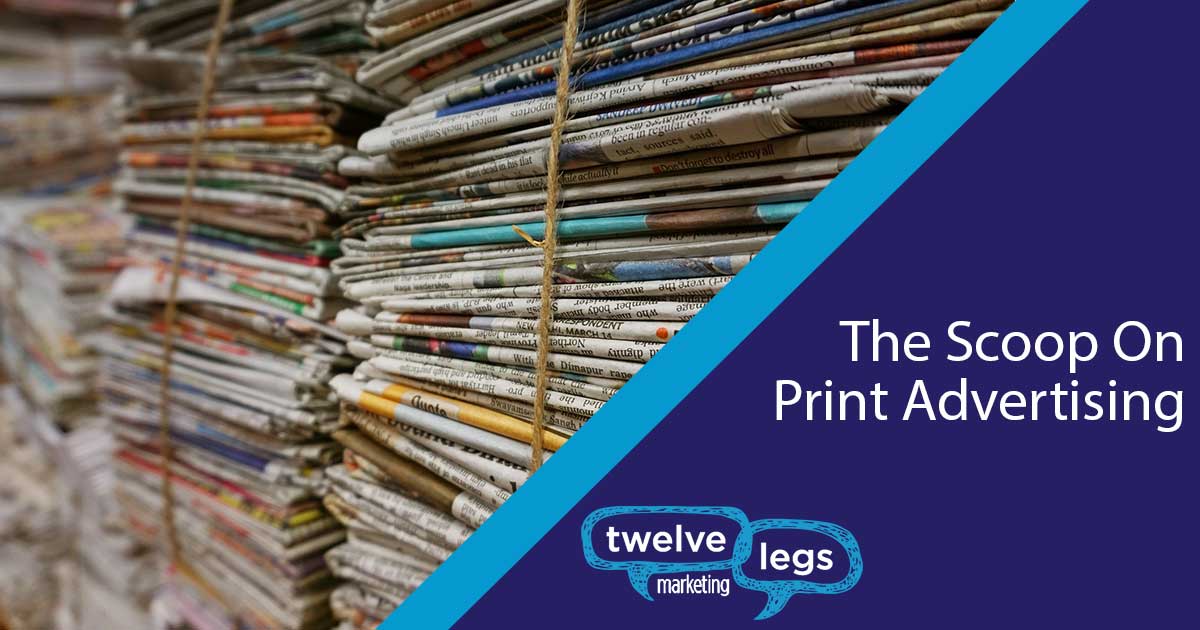The Scoop on Print Advertising

To the digital native, print is something that may have been effective in the town of Bedrock, but this is the 21st Century.
Who pays attention to print advertising anymore?
Our computers, smartphones, and devices spoon feed us targeted ads and content when and where we’re looking, so…
Are Print Ads Dead?
Ultimately it depends on your audience, your budget, and your perspective.
According to AllianceBusinessServices, 56% of customers feel print marketing is still the most trustworthy amongst other avenues of marketing. And 82% of internet users trust print advertising when making a purchasing decision (WebStrategies).
Print readership is still very high among the 65+ age group, and there are some universal pros that will always be associated with print: it’s tangible, credible, engaging, and can be a great branding tool.
All that said, revenue in the newspaper publishing industry decreased by about $4.5 billion between 2011 and 2018, and is projected to continue its downward spiral. Similarly, the future of magazines isn’t very glossy, according to the New York Times.
Marketing Rule of 7
Then there’s the ol’ Marketing Rule of 7. Basically, the more your ad is seen—the more touches your brand has on a potential customer—the more likely you are to move the needle and eventually convert the sale. Of course, that was developed back in the 1930s when movie studios decided seven was the ideal number of times a radio spot had to be heard to boost box office sales.

But Clark doesn’t give a damn, and neither do we…
Fast forward 80 years with all of today’s product noise and competition and the sweet spot number of ad touches is much higher than seven.
Now consider the time and financial investment it takes for your target consumer to see your print ad seven-plus times. Likely thousands of dollars over several months.
With digital marketing, it can be done for pennies on the dollar, and in a fraction of the time.
In the digital age, your ads are constantly seen by customers. Often at least seven times a day—crushing the “Rule of 7” in a mere 24 hours.
So, while print may not be dead just yet, each breath it takes becomes a little more shallow.
The Downsides of Print Advertising
- Print Media Has Diminishing Readership: More and more people are ditching their subscriptions to print publications for the more seamless and convenient online electronic versions.
- Print Media is Expensive: Newspaper and magazine ads can be costly, especially in widely circulated publications, or if you want a big full-color ad. The window in which your ad will be visible is also small, decreasing your ROI.
- Print Media Limits Advanced Targeting: The granularity with which we can find and target online users (geographic, demographic, behavioral, category, contextual, job title, etc.) is truly staggering. Sure, you can be strategic about the publications you show print ads, but with nowhere near the precision of digital capabilities. And without the ability to click and interact with your print ad, you won’t capture any vital user data that can be used to retarget consumers online for maximum exposure and branding.
- Print Media Takes Too Much Time. Most magazines are monthly, and many newspapers will run for only one day so there is a limited timeframe. Scheduling can be a nightmare and unreasonable lead times make your marketing efforts anything but nimble.
- Print Media is Tricky to Measure. Peter F. Drucker once famously said, “you can’t manage what you can’t measure.” Think about it, when was the last time you got an actionable report about your prints ads? Unless you have dedicated phone lines, vanity URLs, and dedicated promo codes, measuring the impact of print is a herculean task. Even with the right tools, you might not see the results you were hoping for, especially for the investment you have made on those color ⅛ page ads.
So What’ll It Be…Print or Digital?
There’s no doubt that print campaigns can pack a punch, elicit an emotional tug, and ultimately prove to be effective.
Plus, a nice multi-platform marketing mix that uses print and digital in complementary lockstep is a good solution for many businesses.
But the fact remains, companies looking to grow through a strategic marketing approach that’s timely, targeted, and cost-effective are turning away from traditional print advertising in favor of increased digital marketing.
There’s simply no match to the depth, breadth, and pinpoint refinement you can accomplish in the digital world. You can tell a much more compelling story with a bevy of personalized content, and you can do it all at the drop of a hat with a relatively small budget.
Sadly, sometimes there’s a catch. Most small businesses don’t have the in-house capacity to manage a digital marketing strategy. Inevitably, they outsource to an agency who has hundreds of digital clients, and they don’t get the care, attention, or results they deserve.
In a perfect world, they’ll get the conscientious attention to detail of an agency with a select client base consisting of mainly small and local businesses.
The world of Twelve Legs Marketing.



